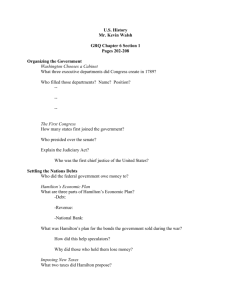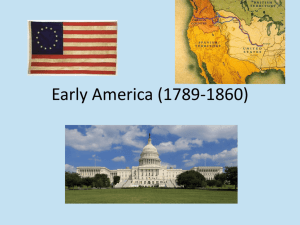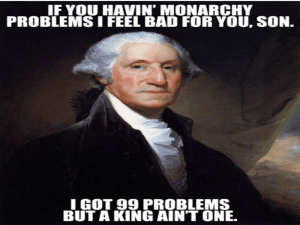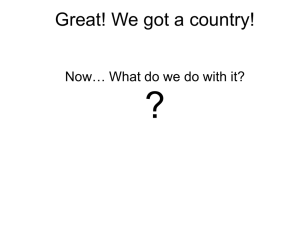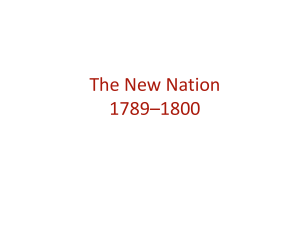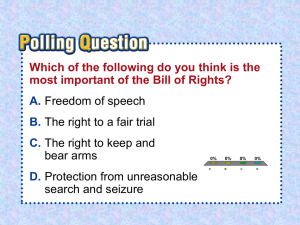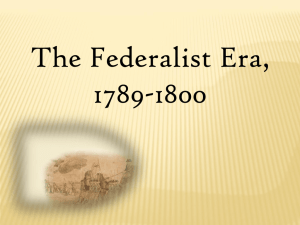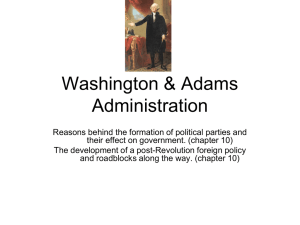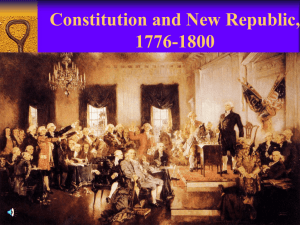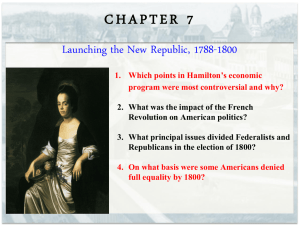Washington Heads the New Government
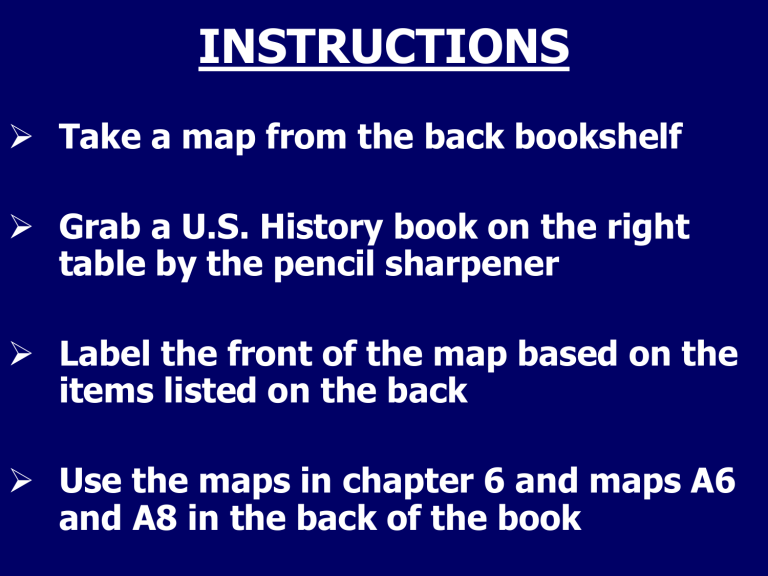
INSTRUCTIONS
Take a map from the back bookshelf
Grab a U.S. History book on the right table by the pencil sharpener
Label the front of the map based on the items listed on the back
Use the maps in chapter 6 and maps A6 and A8 in the back of the book
U.S. HISTORY
CHAPTER 6-1
WASHINGTON HEADS
THE NEW GOVERNMENT
A NEW GOVERNMENT TAKES SHAPE
Washington was the unanimous choice to be the first President
Washington and
Congress established several precedents
(examples) for future leaders to follow
THE JUDICIARY ACT OF 1789
The Constitution authorized
Congress to set up a federal court system, headed by a Supreme Court
In 1789, Congress passed the
Judiciary Act
It set up the Supreme Court, headed by a Chief Justice
THE JUDICIARY ACT OF 1789
It also set up federal courts throughout the country
Section 25 of the Act allowed state court decisions to be appealed to federal courts over constitutional issues
This guaranteed the supremacy of federal laws over state laws on certain issues
WASHINGTON SHAPES
THE EXECUTIVE BRANCH
Congress set up 3 executive departments in
1789 to help run the government:
1) The Department of State affairs to handle foreign
2) The Department of Treasury nation’s finances to handle the
3) The Department of War military to manage the
Congress also created the attorney general to handle the government’s legal matters
WASHINGTON SHAPES
THE EXECUTIVE BRANCH
Washington appointed:
1) Thomas Jefferson as Secretary of
State
2) Alexander Hamilton as Secretary of
Treasury
3) Henry Knox as
Secretary of War
4) Edmund Randolph as Attorney General
WASHINGTON SHAPES
THE EXECUTIVE BRANCH
From these departments
Washington set up what became known as the
cabinet
This is a
group of advisers to the President chosen from the department heads
WASHINGTON SHAPES
THE EXECUTIVE BRANCH
The Constitution states that the president has the power to make treaties and appoint government officials
It is silent, however, on how they are approved by Congress
Washington established the precedent that the Senate could:
1) Approve presidential appointees, but not remove them
2) Ratify or reject treaties only after they were made
WASHINGTON SHAPES
THE EXECUTIVE BRANCH
Washington led the legislative battle, urging Congress to pass laws he believed in the public interest
Congress almost always followed his lead
This precedent was followed by
Washington’s successors, making the
President the Chief Legislator
WARM-UP
Take a copy of Reteach 8-1
On a separate piece of paper answer the questions in the chart, number 1-15. Do not write on the worksheet.
Hold on to your papers and put the worksheet in the basket on the back bookshelf
You have ten minutes to do this
HAMILTON’S ECONOMIC PLAN
The nation had a large national debt from the Revolutionary War
The Continental Congress had borrowed money from foreign governments and private citizens
The national government was responsible for 2/3rds of this debt
The states were responsible for 1/3
HAMILTON’S ECONOMIC PLAN
Secretary of Treasury Hamilton proposed the federal government:
1) Pay off its foreign debt
2) Assume the debts of the states
Hamilton felt assuming the debts of the states would give creditors an incentive to support the new government
Some southern states objected to this as they:
1) had already paid their debts
2) didn’t want to pay for northern debts
HAMILTON’S ECONOMIC PLAN
To win support for his debt plan,
Hamilton suggested moving the nation’s capital from New York City to a new city in the South
In 1790, Congress passed a debt bill, which:
1) Had the federal government take over state debts
2) Authorized the construction of a new national capital in the District of
Columbia (Washington, D.C.)
PLAN FOR A NATIONAL BANK
Hamilton also wanted to create the
Bank of the United States, funded by both the federal government and wealthy investors
He felt this would tie wealthy investors to the country’s welfare
The bank would issue paper money and handle tax receipts and other government funds
PLAN FOR A NATIONAL BANK
The National Bank’s chief opponents were Thomas Jefferson and James Madison
They based their opposition to the
National Bank not being an
enumerated power
Enumerated Power
- Power specifically mentioned in the
Constitution
PLAN FOR A NATIONAL BANK
Hamilton believed that the National
Bank was legal based on implied powers
Implied Powers - Power suggested, but not directly stated in the
Constitution
He used the Elastic Clause of the
Constitution to back up his argument
PLAN FOR A NATIONAL BANK
It states, Congress shall have the power
“To make all laws which shall be necessary and proper for carrying into execution the foregoing powers, and all other powers vested in this Constitution in the government of the United States, or in any department or officer thereof.”
This gives Congress the authority to do whatever is “necessary and proper” to carry out its specific enumerated powers
In the end Congress and Washington sided with Hamilton and signed the
Bank Bill, establishing the Bank of the
United States
HAMILTON & JEFFERSON DEBATE
The political divisions in the nation were embodied in
Washington’s cabinet by
Hamilton and Jefferson
Hamilton believed in:
1) A strong federal government
2) Government run by the educated upper-class
3) An economy based on commerce & industry
HAMILTON & JEFFERSON DEBATE
Jefferson believed in:
1)Strong state and local governments
2)Government rooted in popular participation
3)An economy based on farming
THE FIRST POLITICAL PARTIES
Differences between Hamilton and
Jefferson gave rise to the nation’s first political parties
These parties formed around the issue of the power and size of the federal government in relation to state and local governments
THE FIRST POLITICAL PARTIES
Those who supported Hamilton called themselves Federalists
They believed in a strong federal government
Those who supported Jefferson called themselves Democratic-Republicans
They believed in strong state governments
THE FIRST POLITICAL PARTIES
Washington worried political parties were a danger to national unity
By the time Washington left office, however, the two-party system was firmly established
THE WHISKEY REBELLION
To pay off the nation’s debt, Congress passed a protective tariff in 1789
Protective Tariff - A tax on imports to protect products from foreign competition
Hamilton also wanted an excise tax
Excise tax - Tax paid by the manufacturer of a product and passed on to those who buy
Congress passed the first excise tax in 1791 on Whiskey
THE WHISKEY REBELLION
Most whiskey producers were small frontier farmers
As whiskey was their main source of cash, in 1794, farmers in western
Pennsylvania refused to pay the tax
THE WHISKEY REBELLION
They beat up a federal marshal in Pittsburgh, and tarred and feathered others
Washington personally lead the Army and suppressed the rebellion
The Whiskey Rebellion showed the consolidation of federal power in domestic
(within the U.S.) affairs
